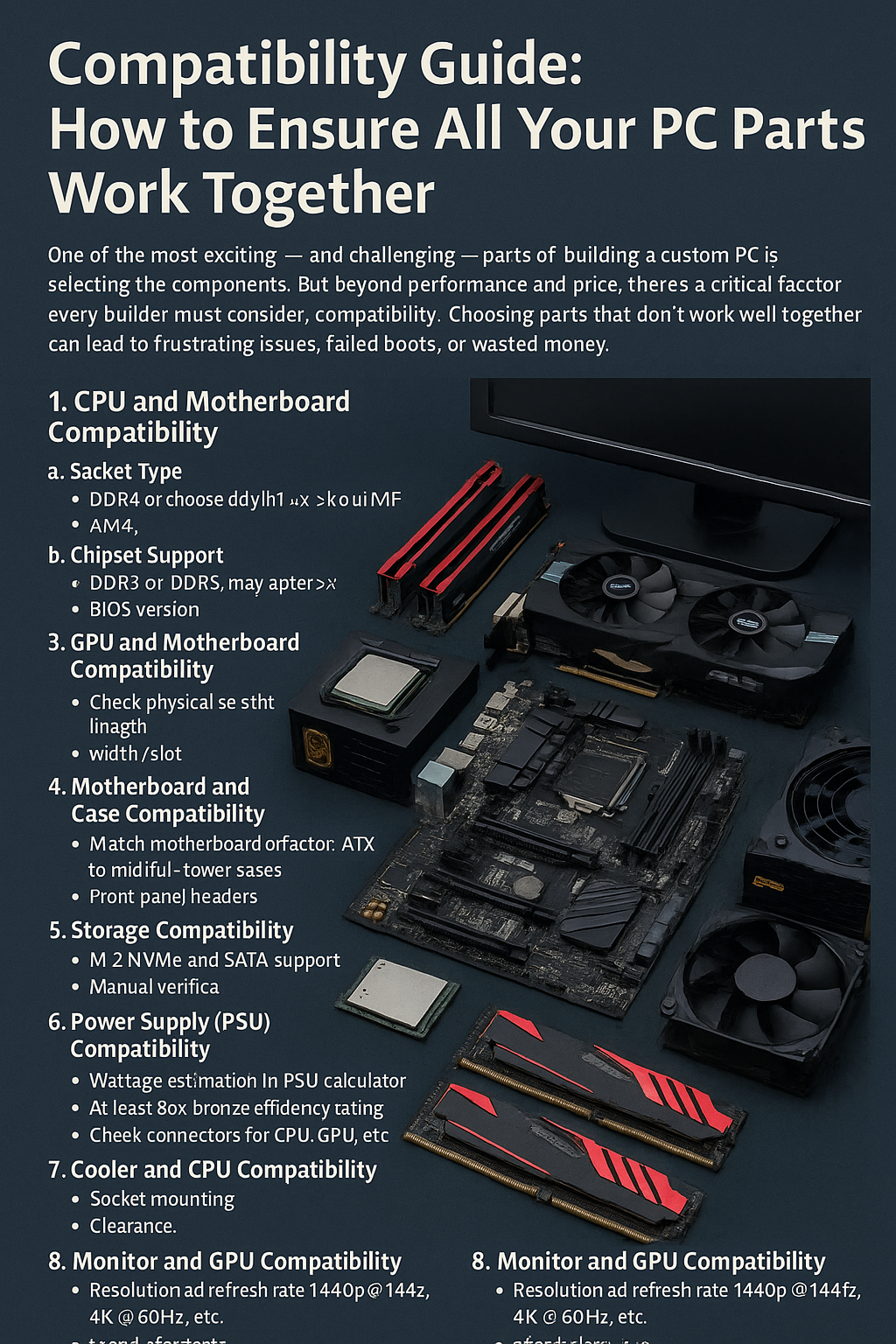One of the most exciting — and challenging — parts of building a custom PC is selecting the components. But beyond performance and price, there’s a critical factor every builder must consider: compatibility. Choosing parts that don’t work well together can lead to frustrating issues, failed boots, or wasted money.
In this detailed guide, you’ll learn how to check for compatibility across every major component to ensure your custom PC build works flawlessly the first time you press the power button.
Why Compatibility Matters
In a PC build, each component must communicate with the others properly. Incompatibilities can cause:
- Your PC to fail to boot
- BIOS errors or crashes
- Limited performance
- Physical fitting issues inside the case
Let’s break down what to check for each part, starting with the foundation: the CPU and motherboard.
1. CPU and Motherboard Compatibility
a. Socket Type
The CPU and motherboard must share the same socket.
- Intel 12th–14th Gen: LGA 1700
- AMD Ryzen 5000: AM4
- AMD Ryzen 7000: AM5
Always check both the socket type and chipset before buying.
b. Chipset Support
Even if the socket matches, the chipset must support your CPU generation.
Example:
- A Ryzen 5600X will work on a B550 or X570 board, but not all A320 boards support it.
- An Intel i9-13900K needs a Z690/Z790 or compatible B660 motherboard with a BIOS update.
c. BIOS Version
Older motherboards may need a BIOS update before supporting newer CPUs. Look for:
- “CPU supported since BIOS version X.XX”
- “Out-of-the-box support” on retailer listings
2. RAM and Motherboard Compatibility
a. DDR Version
RAM must match what your motherboard supports:
- DDR4 or DDR5 (not interchangeable)
For example:
- Most Intel 13th-gen boards support either DDR4 or DDR5 (but not both)
- AMD AM5 motherboards only support DDR5
b. RAM Speed
Your motherboard’s supported speed range matters.
- Motherboards list supported RAM speeds like “3200 MHz (OC)” or “6000 MHz (OC)”
- RAM will still work at lower speeds, but to achieve full performance, the board must support it
c. Capacity and Slots
Check:
- Maximum supported RAM (e.g., 64 GB, 128 GB)
- Number of slots (e.g., 2 or 4 DIMMs)
- Use matched kits for dual-channel performance
3. GPU and Case Compatibility
a. Physical Size
Graphics cards come in different sizes. Check:
- Length (in mm)
- Width (dual-slot, triple-slot)
- Whether it fits inside your case without blocking drives or airflow
Most mid-tower cases fit modern GPUs, but large cards like the RTX 4090 may need a full tower case.
b. Power Supply (PSU) Requirements
Check your GPU’s power needs:
- Required wattage (e.g., 650W+ for high-end cards)
- Required PCIe connectors (e.g., 1x 8-pin, 3x 8-pin, or 12VHPWR for RTX 4000 cards)
Your PSU must meet both the power and connector requirements.
4. Motherboard and Case Compatibility
a. Form Factor
Match the motherboard form factor to your case size:
| Motherboard | Compatible Case Types |
|---|---|
| ATX | Mid-tower, Full-tower |
| Micro-ATX | Mid-tower, some mini cases |
| Mini-ITX | Mini or custom compact cases |
A Micro-ATX board can fit in an ATX case — but not the other way around.
b. Front Panel Headers
Your case includes cables for the power button, reset switch, USB, and audio jacks. Ensure the motherboard has:
- USB 3.2 Gen 1 and Gen 2 headers
- USB-C front panel header (optional)
- HD Audio header
5. Storage Compatibility
a. M.2 NVMe and SATA Support
M.2 slots support both NVMe (PCIe) and SATA SSDs — but not always both in one slot.
- Check your motherboard manual to confirm each slot’s protocol
- If installing multiple M.2 SSDs, some SATA ports may be disabled automatically
b. Drive Quantity
Verify:
- Number of M.2 slots
- Number of SATA ports (usually 4–6)
- Physical room in your case for 2.5” or 3.5” drives
6. Power Supply (PSU) Compatibility
a. Wattage
Estimate your power needs using an online PSU calculator (e.g., from Seasonic or Cooler Master).
Add 100W overhead for future upgrades.
b. Efficiency Rating
Choose a PSU with:
- At least 80+ Bronze rating
- Gold or Platinum for high-end builds
c. Connectors
Ensure your PSU includes:
- 24-pin ATX cable (motherboard)
- 8-pin CPU power cable
- PCIe cables for GPU (6-pin, 8-pin, or 12-pin)
- SATA/Molex for storage and fans
7. Cooler and CPU Compatibility
a. Socket Mounting
Your CPU cooler must support the same socket as your CPU:
- LGA 1700, AM4, AM5, etc.
b. Clearance
Check if the cooler:
- Fits in your case (height for air coolers, radiator size for AIOs)
- Doesn’t block RAM slots
Manufacturers list detailed size specs — always compare with your case clearance.
8. Monitor and GPU Compatibility
a. Resolution and Refresh Rate
Make sure your GPU can support your monitor’s specs:
- 1440p @ 144Hz
- 4K @ 60Hz
- 1080p @ 240Hz
b. Ports
Match the display connection types:
- HDMI 2.0 / 2.1
- DisplayPort 1.4
- USB-C (on some GPUs/monitors)
Use certified cables to avoid display flickering or black screens.
Bonus: Use Online Compatibility Tools
To make your life easier, try:
- PCPartPicker
- Build Redux Compatibility Checker
- Manufacturer support pages and spec sheets
PCPartPicker even alerts you to potential issues like clearance or BIOS requirements.
Final Thoughts: Compatibility Is the Foundation of a Great Build
No matter how powerful or expensive your parts are, they won’t work if they can’t communicate or physically fit together. Compatibility is the backbone of a successful PC build.
Recap Checklist:
✅ CPU and motherboard socket/chipset
✅ RAM type and speed support
✅ GPU size and PSU requirements
✅ Storage slot availability
✅ Case and motherboard form factor
✅ Cooler clearance
✅ Port compatibility (USB, HDMI, etc.)
Taking the time to double-check each component now will save hours of troubleshooting later — and help ensure your PC boots perfectly the first time.
